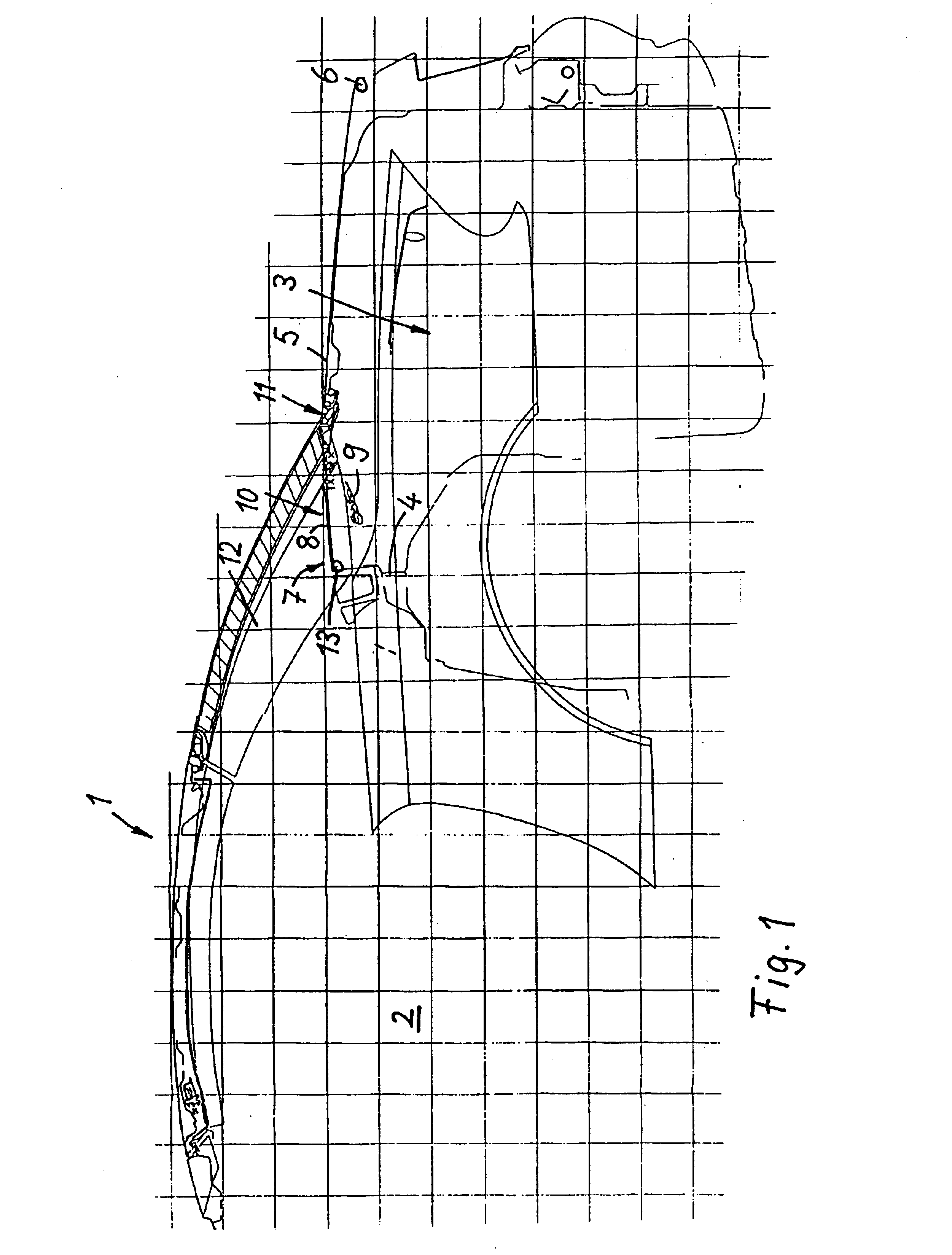With the plate being electrically insulated relative to all adjacent parts, the plate itself can be used as an antenna for the reception of
electromagnetic radiation which is to be supplied to a vehicle radio. Since the plate is insulated with respect to the adjacent components, particularly with respect to the operating mechanism or components thereof, such as its joints, disturbances of the antenna functions are avoided. The plate is particularly suitable for the reception of electromagnetic
waves in the medium-frequency range.
The reinforcement with the metallic support structure further has the
advantage of providing a relatively sturdy structure of relatively low weight. Particularly with a support structure made by
magnesium injection molding the advantages of high stability, low weight and optimal
radio frequency reception can be combined.
The storage shelf, which is disposed in the open space between the
front edge of the vehicle top storage compartment cover and the divider wall between the vehicle interior and the vehicle top storage compartment, then forms a cover member which is movable between a cover position, in which the cover member is arranged essentially horizontally when the vehicle top is in its end positions, that is, in the closed position covering the interior vehicle space or in its open position, in which the vehicle top is deposited in the top storage compartment, and an open position in which the storage compartment, is opened to provide sufficient space for the transfer of the vehicle top between its closed and open positions. The cover member includes a metallic support structure, which preferably consists of
magnesium made expediently by injection molding. The metallic support structure is electrically insulated with respect to an operating drive for moving the cover member, also with respect to joints by way of which the cover member is connected to other vehicle components or, respectively, the vehicle top. Because of the insulation of the cover member with respect to the operating device and with respect to the joints or hinges by way of which the cover member is pivotally supported on a vehicle component, disturbances of the antenna functions are avoided. The cover member is particularly suitable for the reception of electromagnetic
waves in the
intermediate frequency range.
In an advantageous embodiment, the cover member is a two-part member with a front and a rear cover part wherein the rear cover part is hinged to the
front cover part which itself is pivotally connected to a vehicle component. The operating device for actuating the rear cover part extends over the
front cover part and is electrically insulated with respect thereto in order to avoid grounding of the cover to the vehicle body by way of the operating device. The operating device is particularly in the form of a kinematic guide mechanism which cooperates with the movement of the vehicle top in such a way that the rear cover element can be moved, without additional drive means, into a position in which the rear vehicle top storage compartment is fully open to permit removal of the vehicle top from, or its
insertion into, the vehicle top storage compartment. Preferably, in this arrangement, only the
front cover part, which is disposed adjacent the vehicle interior, is electrically insulated with respect to the other vehicle components and also with respect to the rear cover part. Then only the front cover part is used as an antenna. In this way, electrical insulation of the front cover part with respect to the vehicle top storage compartment cover is facilitated.
The insulation between the front and rear cover parts can be achieved by a hinge structure, which consists of a plastic material. The hinge structure may also form a shield, which covers the gap between the front and rear cover parts in an optically pleasing fashion. Also, in the side areas of the cover member, gap shields of electrically insulating material may be attached to the cover member such that, in the closed position of the cover member, the gap shields cover the gaps between the cover member and the adjacent vehicle components. The shields consist preferably of a flexible material, for example of rubber, so that the shields can accommodate varying gap sizes, particularly during relative movement between the front and the rear cover member parts.
The metallic support structure may be in the form of a plate, which provides for high stability, but it may be also be in the form of a lattice structure. A reinforcement may be provided also by a non-metallic part for example of a plastic material.
 Login to View More
Login to View More  Login to View More
Login to View More 


